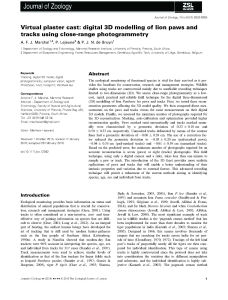Marchal A.F.J., Lejeune P., de Bruyn P. J. N.
The ecological monitoring of threatened species is vital for their survival as it provides the baselines for conservation, research and management strategies. Wildlife studies using tracks are controversial mainly due to unreliable recording techniques limited to two-dimensions (2D). We assess close-range photogrammetry as a lowcost, rapid, practical and reliable field technique for the digital three-dimensional (3D) modelling of lion Panthera leo paws and tracks. First, we tested three reconstruction parameters affecting the 3D model quality. We then compared direct measurements on the paws and tracks versus the same measurements on their digital 3D models. Finally, we assessed the minimum number of photographs required for the 3D reconstruction. Masking, auto-calibration and optimization provided higher reconstruction quality. Paws masked semi-automatically and tracks masked manually were characterized by a geometric deviation of 0.23 ± 0.18 cm and 0.50 ± 0.33 cm respectively. Unmasked tracks delineated by means of the contour lines had a geometric deviation of -0.06 ± 0.39 cm. The use of a correction factor reduced the geometric deviation to -0.03 ± 0.20 cm (pad-masked paws), -0.04 ± 0.35 cm (pad-masked tracks) and -0.01 ± 0.39 cm (unmasked tracks). Based on the predicted error, the minimum number of photographs required for an accurate reconstruction is seven (paws) or eight (tracks) photographs. This field technique, using only a digital camera and a ruler, takes less than one minute to sample a paw or track. The introduction of the 3D facet provides more realistic replications of paws and tracks that will enable a better understanding of their intrinsic properties and variation due to external factors. This advanced recording technique will permit a refinement of the current methods aiming at identifying species, age, sex and individual from tracks.
Consultez la notice complète de l’article sur ORBi

